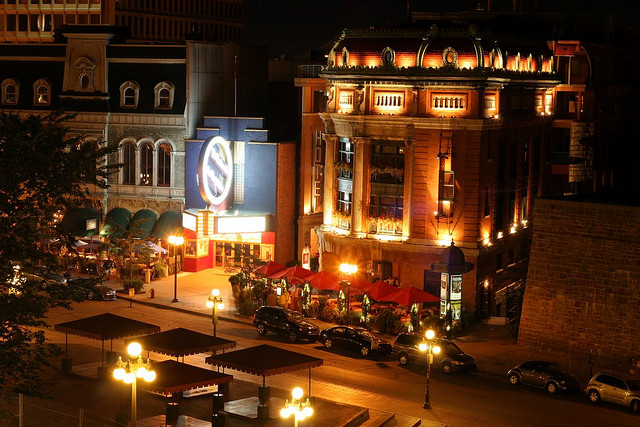
Catch a movie screening or concert at Le Capitole. Photo © Pierre Phaneuf, licensed Creative Commons Attribution.
Québec City is the center for Francophone arts in the country, and the latest in theater and performing arts can be found here, as well as a strong visual arts community. Check out these recommendations from author Sacha Jackson and explore Vieux-Québec’s Upper Town with an eye on the arts.
Opened in 1903, this playhouse retains many of the architectural charms that made it so illustrious back then: a sweeping marble staircase, gold trimmings, and balustrades. Originally the place to see the biggest music hall and vaudeville acts, Le Capitole (972 rue St-Jean, 800/261-9903; $30-120) is mainly a venue for movie screenings and concerts. Tributes to bands like Emerson, Lake, and Palmer and Supertramp are popular, as are classic French singers like Charles Aznavour. It’s here that you’ll also catch long-running performances like the Elvis Story and Ring of Fire (the Johnny Cash musical), often shown with English subtitles.
Built in 1932, this art deco building just outside of the walls was originally a public pool before being converted into a concert hall. After undergoing major reconstruction in 2007, Palais Montcalm (995 Place d’Youville, 877/641-6040; $20-60) has emerged as one of the main centers for artistic life in the city. Seating close to 1,000, this is the home stage of chamber orchestra Les Violons du Roy (the King’s Violins) as well as the site of many jazz, classical, and world music concerts. Along with the large auditorium, it also has a multipurpose café/theater and café/bar.
Founder Raymond Brousseau first started collecting Inuit art in 1956 after receiving a sculpture as a present. In 1974 he opened his first gallery, and it has since become one of the most respected commercial galleries dealing in Inuit art. The large, open space with carpeted floors is a blend between store and gallery, but the aim here is to display the works in the best light possible. Works from four specific regions (Kitikmeot, Kivalliq, Nunavik, and Baffin) are available, each with their own style and materials. The staff at Galerie d’Art Brousseau and Brousseau (35 rue St-Louis, 418/694-1828; daily 9:30am-5:30pm; free) are all expertly qualified in specific fields.
Military barracks, city jail, and an English college make up the past lives of this cultural center dedicated to preserving and sharing the history of Anglophone culture in Québec. Built during the French regime in 1712, the original structure was used to house French troops and eventually prisoners of war. The current neoclassical structure was built in 1808 and was the first jail in Canada based on the ideas of prison reformer John Howard. Converted in 1868, it became the first English college in the city. Today, visitors to the Morrin Centre (44 Chaussée des Écossais, 418/694-9147; Tues. noon-9pm, Wed.-Fri. and Sun. noon-4pm, Sat. 10am-4pm; tours June-Sept. Mon.-Sat. 11am and 3pm, Sun. 1:30pm; tours $9 adult, $7 student, children under 8 free) can see remnants of these histories as they tour the Victorian library and head down to the old jail cells.
This congregation of nuns, the Good Shepherd Sisters of Québec, was established by a mother of three, Marie Fitzbach, in 1856. Started as a women’s shelter, it soon became a place of refuge for marginalized women and abandoned children in the 19th and 20th centuries. Housed in a structure that was built in 1878, the Musée Bon Pasteur (14 rue Couillard, 418/694-0243; Tues.-Sun. 1pm-5pm; $3 adult, $2 senior, $2 student, children 12 and under free) takes up three floors. Exhibits look at the past and future of the congregation, with many personal artifacts of the founders and their predecessors as well as a trip through the trials and tribulations facing Québec women throughout the congregation’s history.
Situated in the shadow of the Château Frontenac, the Musée du Fort (10 rue Ste-Anne, 418/692-2175; Feb.-Mar. and Nov. daily 11am-4pm, Apr.-Oct. daily 10am-5pm, Dec.-Jan. closed; $8 adult, $6 senior, $6 student), located in a historic house, features a 30-minute multimedia show that recreates the six sieges of Québec City and the Battle of the Plains of Abraham. Other highlights include a model of the city as it was in 1759 at the time of British conquest, as well as a small exhibit of weapons, uniforms, and military badges.
As the name suggests the Québec Experience (8 rue du Trésor, 418/694-4000; mid-May-mid-Oct. daily 10am-10pm, mid-Oct.-mid-May daily 10am-5pm; $9.50 adult, $7 senior and student, children under 6 free) invites you to experience the history of Québec City—but in 3D. Admittedly, the technology is in need of an update, and what was once state-of-the-art now feels like a throwback to the late-1980s. Still, if you’re into a bit of kitsch (which is a must in Québec), this show presents all the major events, from the falling bridge to rifle crossfire, and real falling water.
Excerpted from the Third Edition of Moon Montréal & Québec City.